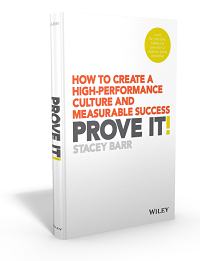|
Paradigm Shifts For a Strategic Performance Breakthrough
Five ways our thinking can shift to lead a measurable strategy that aligns everyone to achieve it.

If we want a breakthrough in how our organisation reaches its goals and makes its impact, it likely requires us to shift our thinking first.
Breakthroughs don’t come by mechanically following the eight PuMP steps, or filling out OKR templates, or dropping succinct strategic objectives onto a Strategy Map. When we follow methods without first aligning our thinking to the principles that gave rise to them, all we do is retrofit, and consequently constrain, those methods to our old ways of thinking.
Our ways of thinking are paradigms. And we can shift our strategic performance management paradigms if they’re holding us back from the breakthroughs we want.
Time and again, we find that leaders are frustrated when the popular strategic frameworks just don’t deliver the breakthrough they promised. Searching for another new framework isn’t always the solution. The solution can be found in shifting the way we think about how to get the most from the frameworks we’re already using.
The paradigms that are most important to shift toward, for a breakthrough in strategic organisational performance, are:
- Focus on the result, before the activity.
- Align results through cause-effect, not copy-paste.
- Use measurement for improvement, not judgement.
- Start measurement with evidence, not data.
- Treat measurement as an integration, not an afterthought.
We'll introduce the meaning of each of these paradigm shifts in this article, and you can download the full white paper, at the end, if you'd like to find out more about:
- what it looks like in action
- clues to test if the shift is needed
- ideas for how to trigger that shift
Paradigm Shift 1: Focus on the result, before the activity.
We need to be clear about our results – the outcomes or impacts we want – before we can know what action will achieve them.
This is a shift away from monitoring goals based on 'what did we do?' and toward monitoring goals based on 'what did we achieve?' and 'how do we know?'
This paradigm shift highlights a tension between action and result. It’s about finding a balance between the pressure to act quickly, and the discipline to be result-oriented or result-driven. Of course we need to act, but acting without intended results means actions will waste time, effort and money.
The key to finding balance with this tension between results versus action is to lead with purpose. This means defining our desired performance results and their measures first and then choosing actions to achieve those results by moving their measures in the right direction.
This first paradigm shift means putting action and results in the appropriate order, to get the results we really want. With PuMP, we start this paradigm shift very early in the strategic performance management cycle, in how strategic plans are structured.

Discover more at PuMP Academy
Watch Our Free Educational Videos...
Here is one video that builds a little on this month's Measure Up topic:
Strategy Frameworks Are Not KPI Frameworks. Strategy frameworks, like Balanced Scorecard or OKRs, might guide us to decide what aspects of performance are important. But they give no practical guidance on exactly how to choose and create and use the measures that are needed to monitor those aspects of performance...

Visit PuMP's YouTube channel for more practical and educational videos on performance measurement and strategy execution.
|








